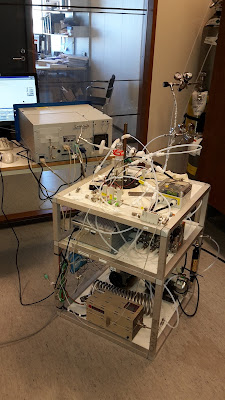The Comparative Reactivity Method at the Finnish Meteorological Institute

As part of my postdoctoral work at the Finnish Meteorological Institute, I developed a new implementation of the Comparative Reactivity Method to measure total hydroxyl (OH) reactivity from ambient air and emissions. The description of the instrument and results from our first study in Helsinki to test the instrument's performances have been published in Atmospheric Environment (open access). The total OH reactivity (also called total OH loss rate) is a measure of how much reactive compounds are present in the air. A higher amount of compounds reduces the lifetime of OH. It appears that the total OH reactivity in forested environments is higher than expected from known measured compounds, mostly volatile organic compounds (VOCs) emitted from the vegetation. In order to study this missing OH sink also observed in the summer in the boreal forest (Sinha et al., 2010; Nölscher et al., 2012) during various seasons, Dr. Heidi Hellén proposed to develop an instrument based on the ...

